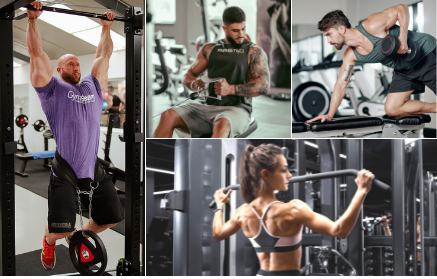Table of Contents
The back muscles are probably one of the most neglected muscle group in the gym. Many people prefer to focus on strengthening their arms or chest, and pay a lot less attention to the back muscles. This is unfortunate, because your back musculature has a significant impact on the appearance and symmetry of your overall figure. What’s more, choosing the right types of exercises is often crucial to treating back pain and other similar issues. One prominent aesthetic advantage of having well-developed back muscles is that it helps to achieve a V-shape physique, which is a dream of both bodybuilders and regular gym goers. Women too, can benefit aesthetically from a strong back, since solid back muscles can help optically thin out the waistline, contributing to that dream hourglass figure. Ultimately, having powerful back muscles means your spine has a proper support, significantly improving your posture.
Training your back applies the same rules as training any other muscle group. Before you start, never forget to properly warm up the muscles you are about to use, preparing them for the strain you are about to put on them. By doing this, you protect yourself from undue injuries. Walking into the gym and heading straight to the barbell to break your personal deadlift record right away is certainly not the healthiest approach. Each exercise on its own also has to follow a certain progression. Before loading up the weights, make sure you’ve learned the proper technique. That’s the only way to achieve the best results.
By using the exercises we are about to discuss in this article, you can put together a full back routine at your gym. To begin, it’s best to pick 2 – 3 exercises that you will perform in three series of 8 – 12 repetitions. Your load should move in between 60 – 75 % of 1RM (maximum performance per 1 rep). Training your back can then stand on its own, or be incorporated with a training session focused on other parts, ideally 2 to 3 times a week. Always keep in mind that a full regeneration of any particular muscle exercised in a strength training session takes from 24 to 72 hours. Considering your regeneration time, make sure you plan your training routine and amount of units within a week accordingly, for each specific muscle group respectively. [1–3]

9 of the most effective exercises for your back and interscapular muscles
To perform all of these exercises, you’ll need the basic equipment available in every gym, such as adjustable bench, barbell with plates, dumbbells, pull-up bar and a pulldown machine. All of these exercises are suitable for both beginners and advanced athletes, adjusting for their level with the manner of execution of the exercise, and the weight used for resistance. It’s up to you how you choose to combine the basic exercises with their variations. Using these exercises, you will be able to construct a complex workout routine for all of your back, from the large muscles such as your traps (m. trapezius) lats (m. latissimus dorsi) as well as the smaller interscapular muscles. Incorporating all of these will eventually lead you to gaining a well-sculpted back musculature.
1. Deadlift
- Starting position: Stand with your feet at the width of your hips. Grasp the barbell with an overhand grip at the width of your shoulders. Bend your knees slightly, keep your back straight and your head in line with your spine. Activate your core.
- Execution: By activating the muscles of your hips and back, lift the barbell smoothly off the ground until the knees and torso are straight. The bar path should be right in front of your legs. Then, breathe in, lower the barbell to the floor in a controlled manner. Then repeat.
- Common mistakes: Bending your back, using unsuitable weight load, short range of motion, uncontrolled movement, leaning your head forward or backward
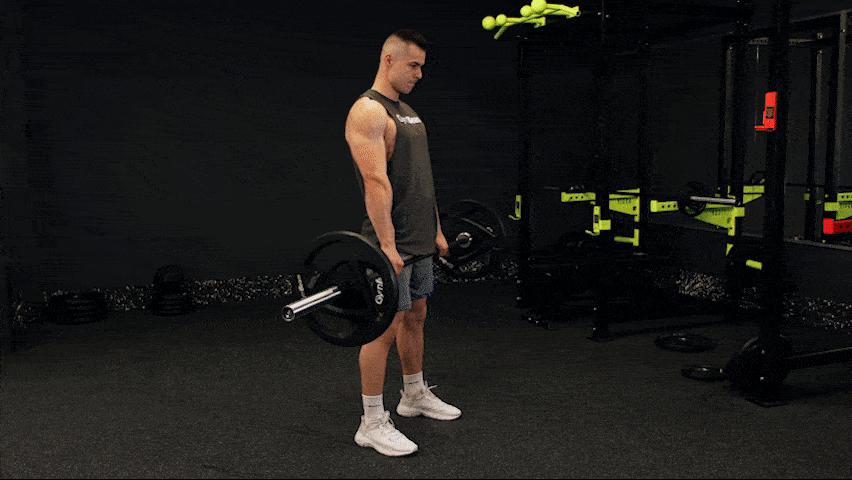
Other variants of the exercise:
1. Double Dumbbell/Kettlebell Deadlift
Dumbbells can be used as an alternative to the barbell. Grasp your dumbbells with an overhand grip, and lift them up following a line just in front of your legs. You can also use kettlebells. Place 2 kettlebells on the sides of your feet and execute a deadlift.
2. Sumo Deadlift
The sumo deadlift allows you to engage your glutes and inner thighs a bit more. Stand in front of the barbell at a stance slightly wider than your shoulders, your toes pointing away from each other. Grasp the barbell roughly at the width of your hips or slightly more narrow. Just like with the regular deadlift, focus on activating your midsection and keeping your back straight.
3. Trap Bar Deadlift
Alternatively, try performing your deadlifts with a trap bar. Trap bar is particularly useful if you suffer from issues involving your lower back, since it forces you to engage your leg muscles a lot more. Stand in the middle of the trap bar, grasp the handles at each side and perform the exercise as described with the regular deadlift.
You might be interested in these products:
2. Barbell Bent Over Row
- Starting position: Stand with your feet at the width of your hips and bend your knees slightly. Lean forward a little, keep your back straight, your shoulders pulled away from your ears, and your head in line with your spine. Grasp the barbell with an overhand grip at the width of your shoulders and lift it to the height of your knees.
- Execution: Pull the barbell up towards your hips contracting your back muscles and breathing out. Lower it back down to your knees in a controlled manner. Repeat.
- Common mistakes: Rounding your back, straightening of the knees, insufficient inclination of the torso, short range of motion.
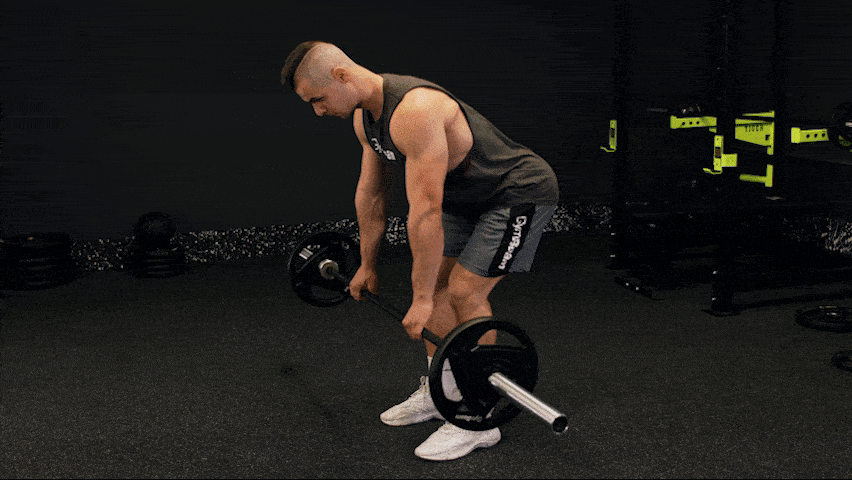
Other variations of the exercise:
1. Dumbbell/Kettlebell Bent Over Row
If you don’t have a barbell at hand, you can perform this exercise using two dumbbells or kettlebells. Grasp them using an overhand grip and pull them up towards your waistline. Your posture should be the same as when using a barbell.
3. Seated Cable Row
- Starting position: Sit on the bench facing the lower pulley. Place your feet on the platform at the opposite end of the bench. Keep your knees slightly bent, the back straight, squeeze your shoulder blade in toward the centre of the back and your head in line with your spine. With both hands, hold the attached V-shaped adapter with the handles at both ends.
- Execution: Exhaling and contracting your back muscles, pull the adapter handle towards your abdomen. Your elbows should be pointing backwards. In the final phase of the movement, bring your shoulders together. Optionally, you can hold this position for 1-2 seconds. Then, with a breath, return to the resting position in a controlled manner and repeat the exercise.
- Common mistakes: Bending and tilting your back too much forward and backward, rounding your back, pulling the shoulders to the ears, insufficient range of motion, swinging of the back

Other variations of the exercise:
1. Wide Grip Seated Cable Row
You can use straight-bar attachment for a low pulley cable station, which allows for a wider grip. This further involves your arms and traps. Execute the exercise in the exact same way as with a V-bar.
2. Single Arm Seated Cable Row
Using a single-hand adapter allows you to exercise each side separately. This may help you pay more attention to properly involving the muscles.
4. Wide Grip Pull Ups
- Starting position: Hang on the pull-up bar using the overhand grip at the width of your shoulders. Activate your midsection and squeeze your shoulder blades down and back.
- Execution: With an exhalation, activate your back and arm muscles and start pulling yourself up in a controlled manner. Point your chest to the bar. Once you get your head slightly above the level of the bar, start lowering yourself down slowly while inhaling. Return to the starting position. Hang from a bar and pull your shoulder blades together and repeat the exercise.
- Common mistakes: Swinging your body, insufficient range of the motion, rounding your back, not squeezing the shoulder blades, using leg swings for going up, excessive backward tilting.
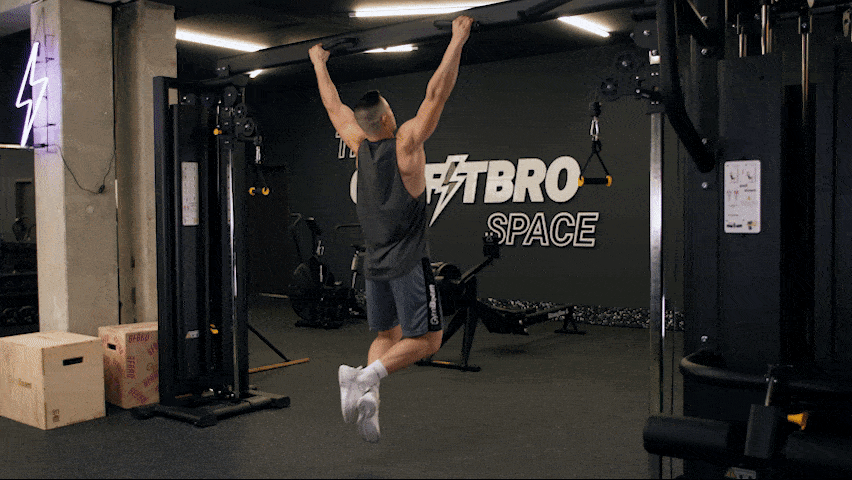
Other variations of the exercise:
1. Resistance Band Assisted Pull Ups
In case you cannot perform unassisted pull-ups, you may want to use a long resistance band. The higher the resistance, the more assistance it will provide to your pull-ups, making them easier. Attach the band to the bar and place one or both of your feet into the loop at the bottom. Once you’re hanging off with some of your weight distributed to the band, execute the pull-up as described above.
2. Machine Assisted Pull Ups
Some gyms are equipped with pull-up machines, which allow you to set up a counterbalance weight. This weight in effect reduces your body weight on the machine, making the exercise easier. This is the ideal starting point for beginners who can’t perform a pull-up even with the help of a resistance band. When using a pull-up machine regularly, you should progressively decrease the counterweight, so that you get stronger as you go.
3. Weighted Pull Ups
Conversely, the exercise can be made more challenging with weighted vests or extra weights that you place in between your knees or attach onto a dip belt. Such a belt can be equipped with additional weight plates or kettlebell.
5. Wide Grip Pulldown
- Starting position: Sit facing the cable machine. Place your feet with their entire surface against the mat. Keep your back straight and the head in line with your spine. Raise your arms and grasp the bar with an overhand grip that is slightly wider than your shoulders.
- Execution: Pull the handlebar down behind your neck while activating your back muscles and exhaling. Optionally, you can remain in this position for 1 – 2 seconds. Inhaling, return to the initial position in a controlled manner. Repeat the exercise.
- Common mistakes: Insufficient range of motion, excessive forward leaning or tilting of the back, swinging motion.
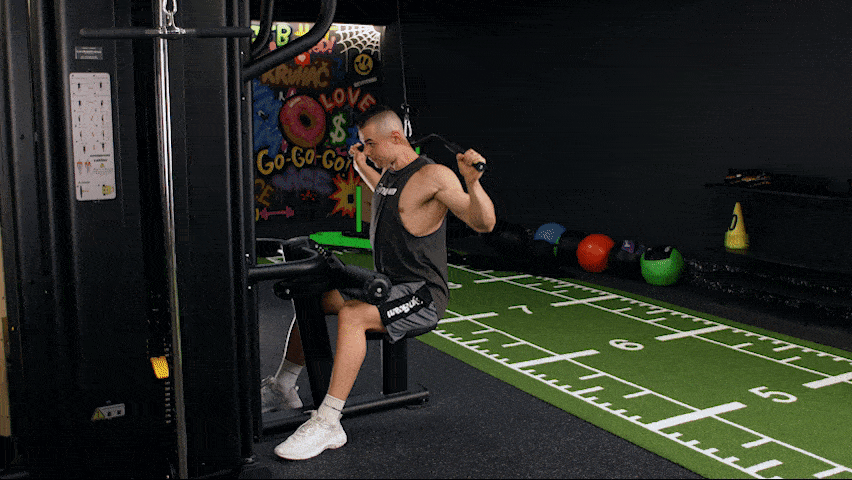
6. Reverse Grip Pulldown
- Starting position: Sit facing the cable machine. Place your feet with their entire surface against the mat. Keep your back straight with a slight backward tilt. Raise your arms and grasp the bar with an underhand grip that is slightly narrower than your shoulders.
- Execution: Pull the handlebar down in front of your chest while activating your back and arm muscles and exhaling. Optionally, you can remain in this position for 1 – 2 seconds. As you inhale, return to the initial position in a controlled manner. Repeat the exercise.
- Common mistakes: Insufficient range of motion, excessive forward leaning or tilting of the back, swinging motion.

Other variants of the exercise:
1. Single Arm Reverse Grip Pulldown
Attach a D-adapter handle to the pulley and grasp it with an overhand grip. Pull towards your shoulder. Complete a series with each arm. This way you can pay more attention to proper muscle activation.
7. Dumbbell Incline Bench Row
- Starting position: Lie down on a bench raised to a 30 – 45-degree angle, with your chest down on the backrest. Keep your head in line with your spine and the shoulders pulled away from your ears. Keep your arms stretched in front of your chest and activate your core.
- Execution: Pull the dumbbells towards your chest, activating your back muscles and exhaling. Your elbows should point away from your body. In the final phase of the movement, pull your shoulder blades together. Optionally, you can hold this position for 1 – 2 seconds. Return to the initial position in a controlled manner with an inhale. Repeat the exercise.
- Common mistakes: Swinging motion, insufficient range of the motion.

Other variants of the exercise:
1. Kettlebell Incline Bench Row
Alternatively, the dumbbells can be substituted with kettlebells. The exercise is executed in the exact same manner.
2. Barbell Incline Bench Row
The dumbbells can also be substituted with a barbell. However, in this case, your range of motion will be smaller, activating your back muscles to a lesser degree.
8. One Arm Dumbbell Row
- Starting position: Put your right knee on a horizontal bench, lean forward and prop yourself with your right hand on the bench, arm fully stretched. Keep your back in a natural curve and your head in line with your spine. Grasp a dumbbell with your left hand.
- Execution: As you exhale, bring the dumbbell towards your waist. Keep your elbow pointing upwards, and your back in a stable position throughout the movement. Optionally, you can hold this position for 1 – 2 seconds. Then bring the dumbbell back down in a controlled fashion as you inhale. Repeat the exercise. Perform a set for each arm.
- Common mistakes: Insufficient range of motion, swinging motion, rounding your back.
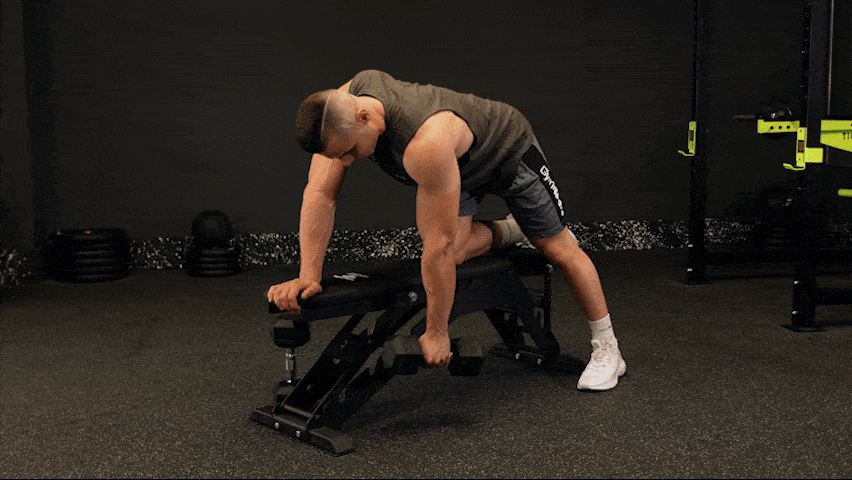
Other variants of the exercise:
1. One Arm Kettlebell Row
The dumbbell can be substituted with a kettlebell. The exercise itself is executed in the exact same manner.
2. Gorilla Row
For this variant, you won’t need a bench, just two kettlebells. Stand up with your feet at a distance slightly wider than your shoulders. Place the kettlebells between your feet. Bend your knees and lean forward, keeping your back straight. Grasp both kettlebells, and bring them up to your chest as you exhale. Your bent elbows should be pointing upwards. Optionally, you can hold this position for 1 – 2 seconds. Bring the kettlebells down slowly and repeat.
9. Standing Cable Pullover
- Starting position: Stand facing the cable machine with your feet parallel to your hips. Bend your knees slightly and lean forward while keeping your back straight. Your head should remain in line with your spine and your shoulders pulled down. Grasp the straight bar attached to the pulley with an overhand grip at the width of your shoulders. Your arms should be stretched out in front of you.
- Execution: Bring the bar down towards your thighs with an exhale, contracting your back muscles. Focus on contracting your lats and pulling your shoulder blades together. Additionally, also focus on maintaining your core activated throughout the exercise. Once you reach this position, you may optionally hold it for 1 – 2 seconds. Breathe in as you return to the initial position in a controlled manner. Repeat the exercise.
- Common mistakes: rounding your back, swinging motion, insufficient range of the motion, excessive or insufficient leaning forward.

What’s next?
- If you’re looking for home workout ideas for training your back, make sure to check out our article 20 Exercises to Help You Relieve Back Pain.
- To relax and stretch stiff back muscles, check out our article on 12 Effective Exercises to Relieve Cervical and Thoracic Spine.
- If you’re looking for exercises that will help you develop your chest muscles, check out our article 7 Best Chest Exercises.
- If you’d like to expand your workout routine with some effective triceps exercises, make sure to read our article 10 Best Triceps Exercises.
- Would you like to learn how to properly plan out your training programme? If so, don’t miss out on our article How to Build a Quality Workout Plan – Tips, Trainings & Most Common Mistakes.
- If you want to learn more about ideal rep range according to your goals, make sure you read our article How Many Reps Should You Do to Lose Weight or Gain Muscle Mass?
What should you remember?
Having a strong and well sculpted back musculature not only looks great, but also contributes to your posture during your trainings as well as your everyday activities. No training plan is complete without effective back exercises. Enrich your plan with deadlifts, cable pullovers, or front rows, and try out the variations available to you. Other effective exercises for your back muscles include T-bar rows or hyperextensions. All listed exercises will help you grow and strengthen your back muscles. To achieve the best results, don’t forget to focus on proper technique and progressive overload. Perform back exercises 2 to 3 times a week. When planning them out, always remember to take your muscle regeneration time into consideration.
Was this article helpful to you? If so, make sure you share it with your friends and inspire them to improve their back workout routine.
[1] Burd, N. A., West, D. W. D., Moore, D. R., Atherton, P. J., Staples, A. W., Prior, T., Tang, J. E., Rennie, M. J., Baker, S. K., & Phillips, S. M. . Enhanced Amino Acid Sensitivity of Myofibrillar Protein Synthesis Persists for up to 24 h after Resistance Exercise in Young Men.– https://doi.org/10.3945/jn.110.135038
[2] Krzysztofik, M., Wilk, M., Wojdała, G., & Gołaś, A. Maximizing Muscle Hypertrophy: A Systematic Review of Advanced Resistance Training Techniques and Methods. – https://doi.org/10.3390/ijerph16244897
[3] Schoenfeld, B. J., Grgic, J., Van Every, D. W., & Plotkin, D. L. Loading Recommendations for Muscle Strength, Hypertrophy, and Local Endurance: A Re-Examination of the Repetition Continuum. – https://doi.org/10.3390/sports9020032

